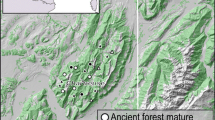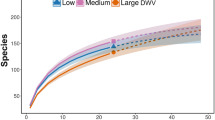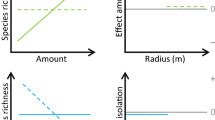Abstract
This study examines the occurrence of saproxylic beetles in woodlands of different size and age and their potential to leave woodland areas and cross open grassland in northern Germany. The beetles were recorded by emergence traps and flight-intercept-traps. The investigated sites were dominated by beech, oak and alder, but other tree species also occurred in low abundance. Species richness showed a positive relation to stand size and age of woods. Both total and rarefaction species richness were the lowest in small and young woods and highest in old and large woods. Species richness decreased asymptotically from the inner-wood habitat to a distance greater than 80 m from the wood margin. 80 species were classified into 46 low mobile species found at a distance <30 m from wood margins and 34 high mobile species found >30 m from wood margins. The most mobile species were found the most frequently in all woods; but they contributed less to species richness in wood stands than did the species with low mobility. The contribution of the least mobile species to species richness in wood stands increased with the age and size of the stands, with the effect of stand size being the greater. We conclude that in our study region woods larger than 100 ha are necessary to maintain the highest richness of the least mobile saproxylic beetles.





Similar content being viewed by others
References
Ammer U (1991) Konsequenzen aus den Ergebnissen der Totholzforschung für die forstliche Praxis. Forstwissenschaftliches Centralblatt 110:149–157
Andersson R, Östlund L (2004) Spatial patterns, density changes and implications on biodiversity for old trees in the boreal landscape of northern Sweden. Biol Conserv 118:443–453
Böhme J (2005) Die Käfer Mitteleuropas Band K Katalog (Faunistische Übersicht). Elsevier, München
Dekoninck W, Desender K, Grootaert P (2008) Establishment of ant communities in forests growing on former agricultural fields: colonisation and 25 years of management are not enough (Hymenoptera: Formicidae). Eur J Entomol 105:681–689
Dobelin B (2006) Ecologie des coléoptères saproxyliques dans les forêts de l’étage montagnard des Alpes du nord françaises. Annales société entomologique de France 42:231–243
Environmental Research Institute (1999) ArcView GIS 3.2. ESRI, Redlands, California
Geiser R (1998) Rote Liste der Käfer (Coleoptera). In: Binot M, Bless R, Boye P, Gruttke H, Pretscher P (eds) Rote Liste gefährdeter Tiere Deutschlands. Schriftenreihe Rat für Landschaftspflege und Naturschutz 55:168–230
Gibb H, Hjältén J, Ball JP, Atlegrim O, Pettersson RB, Hilszczanski J, Johansson T, Danell K (2006a) Effects of landscape composition and substrate availability on saproxylic beetles in boreal forests: a study using experimental logs for monitoring assemblages. Ecography 29:191–204
Gibb H, Pettersson RB, Hjältén J, Hilszczanski J, Johansson T, Atlegrim O, Danell K (2006b) Conservation-oriented forestry and early successional saproxylic beetles: responses of functional groups to manipulated dead wood substrates. Biol Conserv 129:437–450
Grohmann C, Irmler U, Nötzold R (2004) Einfluss von Alter, Fläche und Isolation von Wäldern auf die Totholzkäfer. Faunistisch-Ökologische Mitteilungen 8:259–281
Hedin J, Ranius T (2002) Using radio telemetry to study dispersal of the beetles Osmoderma eremita, an inhabitant of tree hollows. Comput Electron Agric 35:171–180
Irmler U, Heller K, Warning J (1996) Age and tree species as factors influencing the populations of insects living in dead wood (Coleoptera, Diptera: Sciaridae, Mycetophilidae). Pedobiologia 40:134–148
Jongman RHG, ter Braak CJF, van Tongeren OFR (1987) Data analysis in community and landscape ecology. Pudoc, Wageningen
Jonsell M, Weslien J, Ehnström B (1998) Substrate requirements of red-listed saproxylic invertebrates in Sweden. Biodivers Conserv 7:749–764
Jonsell M, Nordlander G, Jonsson M (1999) Colonization patterns of insects breeding in wood-decaying fungi. J Insect Conserv 3:145–161
Jonsell M, Schroeder M, Larsson T (2003) The saproxylic beetle Bolitophagus reticulatus: its frequency in managed forests, attraction to volatiles and flight period. Ecography 26:421–428
Jonsson M (2002) Dispersal ecology of insects inhabiting wood-decaying fungi. Doctoral thesis, University of Uppsala
Junninen K, Similä J, Kotiranta H (2006) Assemblages of wood-inhabiting fungi along gradients of succession and naturalness in boreal pine-dominated forests in Fennoscandia. Ecography 29:75–83
Komonen A, Kouki J (2005) Occurrence and abundance of fungus-dwelling beetles (Ciidae) in boreal forests and clearcuts: habitat associations at two spatial scales. Anim Biodivers Conserv 28:137–147
Krebs CJ (1994) Ecological methodology. Longman, Reading
McLean IFM, Speight MCD (1993) Saproxylic invertebrates—the European context. In: Kirby KJ, Drake CM (eds) Dead wood matters: the ecology and conservation of saproxylic invertebrates in Britain. British Ecological Society, Peterborough, pp 21–32
Ranius T (2002) Influence of stand size and quality of tree hollows on saproxylic beetles in Sweden. Biol Conserv 103:85–91
Ranius T, Hedin J (2001) The dispersal rate of a beetles, Osmoderma eremita, living in tree hollows. Oecologia 126:363–370
Ranius T, Jansson N (2000) The influence of forest regrowth, original canopy cover and tree size on saproxylic beetles associated with old oaks. Biol Conserv 95:85–94
Ranius T, Aguado LO, Antonsson K, Audisio P, Ballerio A, Carpaneto GM, Chobot K, Gjurasin B, Hanssen O, Huijbregts H, Lakatos F, Martin O, Neculiseanu Z, Nikitsky NB, Paill W, Pirnat A, Rizun V, Ruicanescu A, Stegner J, Süda I, Szwalko P, Tamutis V, Telnov D, Tsinkevich V, Versteirt V, Vignon V, Vögeli M, Zach P (2005) Osmoderma eremita (Coleoptera, Scarabaeidae, Cetoniinae) in Europe. Anim Biodivers Conserv 28:1–44
Rauh J, Schmitt M (1991) Methodik und Ergebnisse der Totholzforschung in Naturwaldreservaten. Forstwissenschaftliches Centralblatt 110:114–127
Rink M (2006) Der Hirschkäfer Lucanus cervus in der Kulturlandschaft: Ausbreitungsverhalten, Habitatnutzung und Reproduktionsbiologie im Flusstal. Doctoral thesis, University of Koblenz-Landau
Schiegg KG (1999) Limiting factors of saproxylic insects: habitat relationships of an endangered ecological group. Dissertation, University of Zürich
Siitonen J (2001) Forest management, coarse woody debris and saproxylic organisms: Fennoscandian boreal forests as an example. Ecol Bull 49:11–41
Similä M, Kouki J, Martikainen P (2003) Saproxylic beetles in managed and seminatural Scots pine forests: quality of dead wood matters. For Ecol Manag 174:365–381
Speight MCD (1989) Saproxylic invertebrates and their conservation. Council of Europe, Strasbourg
Statsoft (1998) Statistica für Windows (Computer-Programm-Handbuch). StatSoft Inc., Tulsa
Sverdrup-Thygeson A (2001) Can ‘continuity indicator species’ predict species richness or red-listed species of saproxylic beetles? Biodivers Conserv 10:815–832
Ter Braak CJF, Smilauer P (1998) Canoco for windows version 4.0. Centre for Biometry, Wageningen
Vodka S, Konvicka M, Cizek L (2009) Habitat preferences of oak-feeding xylophagous beetles in a temperate woodland: implications for forest history and management. J Insect Conserv 13:553–562
Ziegler W, Suikat R (1994) Rote Liste der in Schleswig-Holstein gefährdeten Käferarten. Kiel. Landesamt für Naturschutz und Landschaftspflege, Flintbek, Germany
Acknowledgments
The study was financially supported by the Federal Ministry of Education and Research of Germany.
Author information
Authors and Affiliations
Corresponding author
Rights and permissions
About this article
Cite this article
Irmler, U., Arp, H. & Nötzold, R. Species richness of saproxylic beetles in woodlands is affected by dispersion ability of species, age and stand size. J Insect Conserv 14, 227–235 (2010). https://doi.org/10.1007/s10841-009-9249-7
Received:
Accepted:
Published:
Issue Date:
DOI: https://doi.org/10.1007/s10841-009-9249-7




